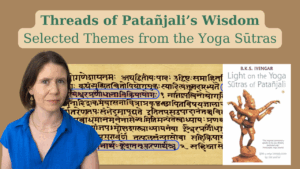
Threads of Patanjali’s Wisdom recording of Session 3
Session 3 – Threads in Patañjali’s Wisdom For Session 4: Āsana as a Path to Samādhi We explore Patañjali’s teaching on āsana, and more

In the vast repertoire of yoga asanas, two poses stand as pillars of transformative practice: Sarvangasana (Shoulder Stand) and Sirsasana (Headstand). Geeta Iyengar, in her masterpiece “Yoga: A Gem for Women,” presents these inversions as complementary forces, describing them through rich metaphors that reveal their profound impact on our physical, mental, and emotional well-being.
Imagine a kingdom where two rulers work in perfect harmony. This is how Geeta Iyengar describes these poses: Sirsasana as the King of Asanas, and Sarvangasana as the Queen. But this isn’t just poetic language – it reflects their distinct yet complementary effects on our system. Where Sirsasana cultivates sharp intellectual clarity, strong willpower, and mental precision, Sarvangasana devhttps://www.agiwittich.co.il/lecture/aligning-with-change-iyengar-yogas-adaptations-for-womens-life-cycles/elops emotional stability, nurturing patience, and inner calm. This partnership creates a complete system for personal transformation.
The maternal quality of Sarvangasana is particularly significant in Geeta’s teachings. She describes it as the “mother of asanas,” explaining that “as a mother struggles throughout her life for the happiness of her children, the ‘mother of asanas’ strives for peace and health of the body.” This maternal nature is reflected in its deeply nurturing effects on the nervous system, its ability to calm anxiety and stress, regulate hormonal balance, and promote restful sleep. It’s a pose that truly nurtures the practitioner from the inside out.If you’re curious about how these qualities connect with Ayurveda and hormonal balance, check out Geeta Iyengar’s Ayurvedic Wisdom.
Reflect: What changes in your inner landscape when you remain upside down for a while?
One of Geeta’s most crucial teachings about these poses is their interdependence. She emphatically states that Sirsasana must always be followed by Sarvangasana. This isn’t just tradition – it’s based on profound understanding of their effects. Practicing Sirsasana alone can lead to irritability, emotional imbalance, and mental agitation. The calming, grounding qualities of Sarvangasana are needed to balance the energizing, stimulating effects of Sirsasana. This relationship exemplifies the yogic principle of finding balance in all things. Geeta expands on balancing principles for life stages in Aligning With Change: Iyengar Yoga and Women’s Cycles.
The physical benefits of these inversions are extensive. According to Geeta, they improve blood circulation to the brain, stimulate endocrine glands, strengthen the spine, aid digestive function, and support respiratory health. But their impact goes far beyond the physical. On a mental level, they enhance memory and concentration, reduce mental fatigue, promote emotional equilibrium, build self-confidence, and develop mental clarity. For women specifically, these poses offer therapeutic benefits for menstrual disorders, hormonal fluctuations, menopausal symptoms, headaches, and reproductive health.
Reflect: Do you ever notice fear, resistance, or joy when approaching inversions? Why might that be?
In her teachings, Geeta emphasizes the importance of proper preparation and practice. She stresses that preparation is key – practitioners must master preliminary poses first, build strength gradually, and understand proper alignment. Timing matters too – these poses should be practiced early in your sequence, with equal duration maintained in both poses. Beginning practitioners should start with shorter holds and gradually increase duration as their strength and understanding develop.
The transformative potential of these inversions goes beyond their physical and mental benefits. They are tools for profound spiritual growth, helping practitioners develop not just physical resilience and mental clarity, but also emotional stability and inner peace. Through regular practice, they become gateways to deeper self-understanding and spiritual awareness.
However, Geeta is clear that these powerful poses require respect and careful approach. Proper preparation, teacher guidance, awareness of limitations, and respect for contraindications are essential. These poses should be approached progressively, with patience and attention to detail. The use of props and walls for support is encouraged when needed, as alignment should never be compromised for duration.
Sarvangasana and Sirsasana, as presented by Geeta Iyengar, offer us a complete system for physical health and mental well-being. Their complementary nature reminds us of the importance of balance in our practice and in our lives. When approached with respect, understanding, and proper guidance, these royal inversions become powerful tools for transformation, leading us toward greater health, clarity, and inner peace. As Geeta reminds us, together they form a perfect partnership for our yogic journey, offering us both the strength to grow and the nurturing to heal.
This royal partnership of poses stands as a testament to the profound wisdom embedded in the yoga tradition. Through Geeta Iyengar’s clear and insightful teachings, we can better understand and appreciate these invaluable tools for transformation, using them to cultivate both strength and serenity in our practice and our lives.
If this reflection deepened your own practice, you’re welcome to support my work with a chai.
Exploring how the mind reacts when the body is turned upside down is a fascinating doorway into the philosophy of perception. I explore this more deeply in my lecture on The Sāṁkhya Model of Mind — for those who want to understand the mental map yoga inherited from ancient India.

Session 3 – Threads in Patañjali’s Wisdom For Session 4: Āsana as a Path to Samādhi We explore Patañjali’s teaching on āsana, and more

Session 2 – Threads in Patañjali’s Wisdom For Session 3: Abhyāsa and Vairāgya We explore the twin pillars that support all yogic transformation: अभ्यास

Session 1 – Threads in Patañjali’s Wisdom For Session 2: Yoga and the Mind We explore Patañjali’s foundational definition: “Yoga is the control of
Agi Wittich is a yoga practitioner since two decades, and is a certified Iyengar Yoga teacher. Wittich studied Sanskrit and Tamil at the Hebrew University of Jerusalem, Israel, completing a PhD with a focus on Hinduism, Yoga, and Gender. She has published academic papers exploring topics such as Iyengar yoga and women, the effects of Western media on the image of yoga, and an analysis of the Thirumanthiram yoga text.